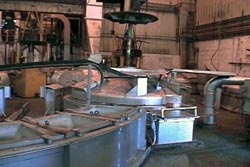Lead: Secondary Lead Smelter eTool
Refining and Casting » Refining
Typically, metal from the smelting furnace is melted in an indirect-fired kettle or pot and the trace elements are combined to produce the desired alloy. Employees may be exposed to lead fume and particulate during the refining process.
Potential Sources of Exposure
-
Lead particulate may become airborne due to updrafts created by thermal rise from the surface of the refining kettle during preheating and cleaning.
-
Lead fumes or particulate may be emitted from the surface of the molten lead during the transfer of lead to the kettle and from the kettle during melting, adding refining agents, and stirring of molten alloy.
-
Lead emissions may occur while drossing lead kettles.
-
Settled dust may be reentrained due to vibrating equipment and vehicular traffic in the area.
Engineering and Work Practice Controls


- Provide exhaust ventilated enclosure for refining kettles (Fig. 1).
- Enclose and exhaust ventilate all launders (Fig. 2).
-
Pump rather than pour molten lead when possible.
-
Keep molten lead temperatures to a minimum to reduce lead fume generation.
-
Provide local exhaust ventilation hoods and ductwork that does not interfere with the use of overhead cranes.
-
Provide roll back access doors to allow the addition of refining agents.
- Provide a supplied air island near the refining kettle.


